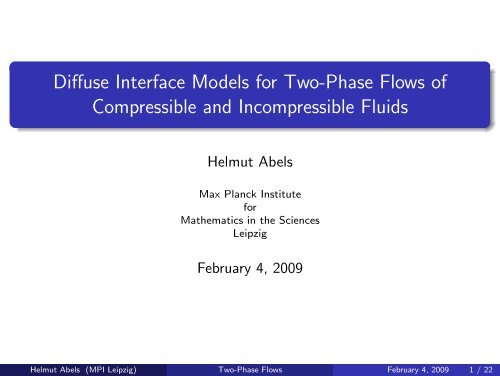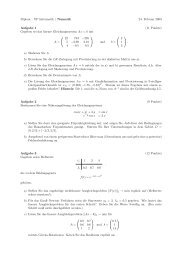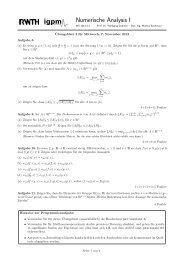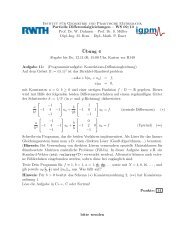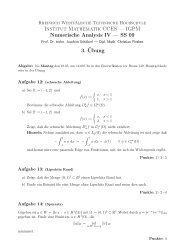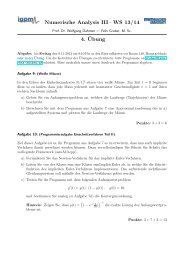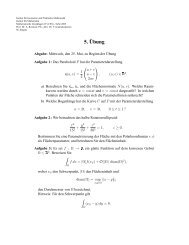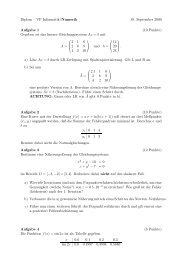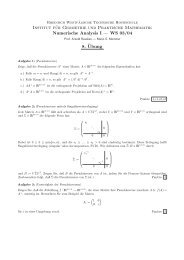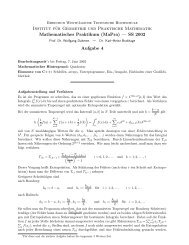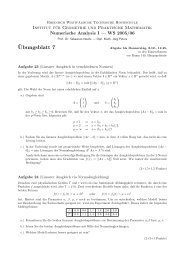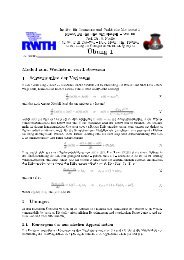Diffuse Interface Models for Two-Phase Flows of Compressible and ...
Diffuse Interface Models for Two-Phase Flows of Compressible and ...
Diffuse Interface Models for Two-Phase Flows of Compressible and ...
Create successful ePaper yourself
Turn your PDF publications into a flip-book with our unique Google optimized e-Paper software.
<strong>Diffuse</strong> <strong>Interface</strong> <strong>Models</strong> <strong>for</strong> <strong>Two</strong>-<strong>Phase</strong> <strong>Flows</strong> <strong>of</strong><br />
<strong>Compressible</strong> <strong>and</strong> Incompressible Fluids<br />
Helmut Abels<br />
Max Planck Institute<br />
<strong>for</strong><br />
Mathematics in the Sciences<br />
Leipzig<br />
February 4, 2009<br />
Helmut Abels (MPI Leipzig) <strong>Two</strong>-<strong>Phase</strong> <strong>Flows</strong> February 4, 2009 1 / 22
Overview<br />
1 <strong>Diffuse</strong> <strong>Interface</strong> Model <strong>for</strong> Incompressible Fluids – Matched Densities<br />
2 <strong>Diffuse</strong> <strong>Interface</strong> Model <strong>for</strong> <strong>Compressible</strong> Fluids<br />
3 <strong>Diffuse</strong> <strong>Interface</strong> Model <strong>for</strong> Incompressible Fluids – General Densities<br />
4 Open Questions<br />
Helmut Abels (MPI Leipzig) <strong>Two</strong>-<strong>Phase</strong> <strong>Flows</strong> February 4, 2009 2 / 22
Overview<br />
1 <strong>Diffuse</strong> <strong>Interface</strong> Model <strong>for</strong> Incompressible Fluids – Matched Densities<br />
2 <strong>Diffuse</strong> <strong>Interface</strong> Model <strong>for</strong> <strong>Compressible</strong> Fluids<br />
3 <strong>Diffuse</strong> <strong>Interface</strong> Model <strong>for</strong> Incompressible Fluids – General Densities<br />
4 Open Questions<br />
Helmut Abels (MPI Leipzig) <strong>Two</strong>-<strong>Phase</strong> <strong>Flows</strong> February 4, 2009 3 / 22
Basic Modeling Assumptions<br />
We consider two (macroscopically) immiscible incompressible, viscous<br />
fluids like oil <strong>and</strong> water.<br />
Classical <strong>Models</strong>: <strong>Interface</strong> is a two-dimensional surface.<br />
Surface tension is proportional to the mean curvature.<br />
Surface energy is proportional to the area.<br />
Helmut Abels (MPI Leipzig) <strong>Two</strong>-<strong>Phase</strong> <strong>Flows</strong> February 4, 2009 4 / 22
Basic Modeling Assumptions<br />
We consider two (macroscopically) immiscible incompressible, viscous<br />
fluids like oil <strong>and</strong> water.<br />
Classical <strong>Models</strong>: <strong>Interface</strong> is a two-dimensional surface.<br />
Surface tension is proportional to the mean curvature.<br />
Surface energy is proportional to the area.<br />
But: Sharp <strong>Interface</strong> is an idealization (van der Waals).<br />
Fluid mix in a thin interfacial region.<br />
Helmut Abels (MPI Leipzig) <strong>Two</strong>-<strong>Phase</strong> <strong>Flows</strong> February 4, 2009 4 / 22
Free Energy <strong>of</strong> a <strong>Two</strong>-Component Mixture<br />
Ansatz: We assume the fluids to be (partly) miscible.<br />
Let c j : Ω → R be the concentration <strong>of</strong> the component j = 1, 2,<br />
c = c 1 − c 2 , <strong>and</strong> let<br />
E mix (c) = ε ∫<br />
∫<br />
|∇c(x)| 2 dx + ε −1 f (c(x)) dx<br />
2<br />
Ω<br />
Ω<br />
be the free energy <strong>of</strong> the mixture, where Ω ⊆ R d ,<br />
d = 1, 2, 3, ε > 0 <strong>and</strong><br />
f : R → [0, ∞) with f (c) = 0 ⇔ c = ±1.<br />
Example:<br />
f (c) = 1 8 (1 − c2 ) 2<br />
Helmut Abels (MPI Leipzig) <strong>Two</strong>-<strong>Phase</strong> <strong>Flows</strong> February 4, 2009 5 / 22
Free Energy <strong>of</strong> a <strong>Two</strong>-Component Mixture<br />
Ansatz: We assume the fluids to be (partly) miscible.<br />
Let c j : Ω → R be the concentration <strong>of</strong> the component j = 1, 2,<br />
c = c 1 − c 2 , <strong>and</strong> let<br />
E mix (c) = ε ∫<br />
∫<br />
|∇c(x)| 2 dx + ε −1 f (c(x)) dx<br />
2<br />
Ω<br />
Ω<br />
be the free energy <strong>of</strong> the mixture, where Ω ⊆ R d ,<br />
d = 1, 2, 3, ε > 0 <strong>and</strong><br />
f : R → [0, ∞) with f (c) = 0 ⇔ c = ±1.<br />
Moreover, we assume<br />
∫<br />
1<br />
c(x) dx = c ∈ (−1, 1) if |Ω| < ∞.<br />
|Ω|<br />
Ω<br />
Example:<br />
f (c) = 1 8 (1 − c2 ) 2<br />
Helmut Abels (MPI Leipzig) <strong>Two</strong>-<strong>Phase</strong> <strong>Flows</strong> February 4, 2009 5 / 22
Remarks<br />
A “typical” pr<strong>of</strong>ile <strong>of</strong> a diffuse interface is<br />
c(x) = tanh x 2ε , x ∈ R,<br />
which minimizes E mix in the case Ω = R with constraint<br />
c(x) → x→±∞ ±1 if f (c) = 1 8 (1 − c2 ) 2 .<br />
Helmut Abels (MPI Leipzig) <strong>Two</strong>-<strong>Phase</strong> <strong>Flows</strong> February 4, 2009 6 / 22
Remarks<br />
A “typical” pr<strong>of</strong>ile <strong>of</strong> a diffuse interface is<br />
c(x) = tanh x 2ε , x ∈ R,<br />
which minimizes E mix in the case Ω = R with constraint<br />
c(x) → x→±∞ ±1 if f (c) = 1 8 (1 − c2 ) 2 .<br />
Modica-Mortola ’77, Modica ’87 proved<br />
E mix ≡ E mix,ε → ε→0 σP<br />
in the sense <strong>of</strong> Γ-convergence (w.r.t. L 1 ), where<br />
{<br />
H d−1 (∂ ∗ E) if v = 2χ E − 1<br />
P(v) =<br />
+∞ else.<br />
<strong>and</strong> σ = σ(f ).<br />
Helmut Abels (MPI Leipzig) <strong>Two</strong>-<strong>Phase</strong> <strong>Flows</strong> February 4, 2009 6 / 22
Modeling <strong>of</strong> a <strong>Two</strong>-<strong>Phase</strong> Flow<br />
Ansatz: Use the free energy<br />
E mix (c) = ε ∫<br />
∫<br />
|∇c(x)| 2 dx + ε −1<br />
2<br />
to describe the energy <strong>of</strong> the mixture.<br />
Ω<br />
Ω<br />
f (c(x)) dx<br />
Helmut Abels (MPI Leipzig) <strong>Two</strong>-<strong>Phase</strong> <strong>Flows</strong> February 4, 2009 7 / 22
Modeling <strong>of</strong> a <strong>Two</strong>-<strong>Phase</strong> Flow<br />
Ansatz: Use the free energy<br />
E mix (c) = ε ∫<br />
∫<br />
|∇c(x)| 2 dx + ε −1<br />
2<br />
Ω<br />
to describe the energy <strong>of</strong> the mixture.<br />
Diffusion: Take diffusion <strong>of</strong> mass particles into account<br />
∂ t c + v · ∇c = div J<br />
µ := δE mix<br />
δc<br />
J = m∇µ<br />
Ω<br />
f (c(x)) dx<br />
(continuity equation)<br />
(generalized Fick’s law)<br />
:= −ε∆c + ε −1 f ′ (c) (chemical potential)<br />
where v is the mean velocity <strong>of</strong> the mixture <strong>and</strong> m > 0.<br />
Classical models: Pure transport <strong>of</strong> the interface (m=0).<br />
Remark: µ = δE mix<br />
δc<br />
≡ const. ⇔ J ≡ 0<br />
Helmut Abels (MPI Leipzig) <strong>Two</strong>-<strong>Phase</strong> <strong>Flows</strong> February 4, 2009 7 / 22
<strong>Diffuse</strong> <strong>Interface</strong> Model in the Case <strong>of</strong> Matched Densities<br />
If the densities <strong>of</strong> the fluids are the same, then one can derive:<br />
∂ t v + v · ∇v − div(ν(c)Dv) + ∇p = −ε div(∇c ⊗ ∇c) (1)<br />
} {{ }<br />
surface tension<br />
div v = 0 (2)<br />
∂ t c + v · ∇c = m∆µ (3)<br />
where Dv = 1 2 (∇v + ∇v T ) <strong>and</strong> ν(c) ≥ ν 0 > 0.<br />
Derivation: Hohenberg & Halperin ’74, Gurtin et al. ’96<br />
µ = −ε∆c + ε −1 f ′ (c) (4)<br />
Moreover, let Ω ⊂ R d be a bounded domain with smooth boundary <strong>and</strong><br />
v| ∂Ω = 0 (5)<br />
∂ n c| ∂Ω = ∂ n µ| ∂Ω = 0 (6)<br />
(v, c)| t=0 = (v 0 , c 0 ) (7)<br />
Helmut Abels (MPI Leipzig) <strong>Two</strong>-<strong>Phase</strong> <strong>Flows</strong> February 4, 2009 8 / 22
<strong>Diffuse</strong> <strong>Interface</strong> Model in the Case <strong>of</strong> Matched Densities<br />
If the densities <strong>of</strong> the fluids are the same, then one can derive:<br />
∂ t v + v · ∇v − div(ν(c)Dv) + ∇p = −ε div(∇c ⊗ ∇c) (1)<br />
} {{ }<br />
surface tension<br />
div v = 0 (2)<br />
∂ t c + v · ∇c = m∆µ (3)<br />
µ = −ε∆c + ε −1 f ′ (c) (4)<br />
where Dv = 1 2 (∇v + ∇v T ) <strong>and</strong> ν(c) ≥ ν 0 > 0.<br />
Energy dissipation: Every smooth solutions satisfies<br />
∫<br />
d<br />
dt<br />
∫Ω<br />
E(c(t), v(t)) = − ν(c)|Dv| 2 dx − m|∇µ| 2 dx<br />
Ω<br />
∫<br />
|v(t)| 2<br />
E(c(t), v(t)) = E mix (c(t)) + dx<br />
2<br />
Ω<br />
with<br />
Helmut Abels (MPI Leipzig) <strong>Two</strong>-<strong>Phase</strong> <strong>Flows</strong> February 4, 2009 8 / 22
<strong>Diffuse</strong> <strong>Interface</strong> Model in the Case <strong>of</strong> Matched Densities<br />
If the densities <strong>of</strong> the fluids are the same, then one can derive:<br />
∂ t v + v · ∇v − div(ν(c)Dv) + ∇p = −ε div(∇c ⊗ ∇c) (1)<br />
} {{ }<br />
surface tension<br />
div v = 0 (2)<br />
where Dv = 1 2 (∇v + ∇v T ) <strong>and</strong> ν(c) ≥ ν 0 > 0.<br />
Remark: (1) can be replaced by:<br />
∂ t c + v · ∇c = m∆µ (3)<br />
∂ t v + v · ∇v − div(ν(c)Dv) + ∇g = µ∇c<br />
µ = −ε∆c + ε −1 f ′ (c) (4)<br />
where g = p + ε −1 f (c) + ε 2 |∇c|2 . – Use (4) multiplied with ∇c, which<br />
yields<br />
−ε div(∇c ⊗ ∇c) = −ε∆c∇c − ε∇ |∇c|2<br />
2<br />
Note: (1)-(4) is not too strongly coupled!<br />
Helmut Abels (MPI Leipzig) <strong>Two</strong>-<strong>Phase</strong> <strong>Flows</strong> February 4, 2009 8 / 22
Main Results <strong>for</strong> Matched Densities<br />
Theorem (Existence, Regularity, Uniqueness, A. (ARMA ’08))<br />
Let d = 2, 3. For every v 0 ∈ L 2 σ(Ω), c 0 ∈ H 1 (Ω) with E mix (c 0 ) < ∞ there<br />
is a weak solution (v, c, µ) <strong>of</strong> (1)-(4), which satisfies<br />
(v, ∇c) ∈ L ∞ (0, ∞; L 2 (Ω)),<br />
∇ 2 c, f ′ (c) ∈ L 2 loc ([0, ∞); L6 (Ω)).<br />
For (v 0 , c 0 ) sufficiently smooth:<br />
(∇v, ∇µ) ∈ L 2 (0, ∞; L 2 (Ω)),<br />
1 If d = 2, then the weak solution is unique <strong>and</strong> regular.<br />
2 If d = 3, there are some 0 < T 0 < T 1 < ∞ such that the weak<br />
solution is regular <strong>and</strong> (locally) unique on (0, T 0 ) <strong>and</strong> [T 1 , ∞).<br />
Remark: Here f (c) can be chosen as e.g.<br />
{<br />
θ((1 − c) log(1 − c) + (1 + c) log(1 + c))c − θ c c 2 , if c ∈ [−1, 1],<br />
f (c) =<br />
+∞ else.<br />
Helmut Abels (MPI Leipzig) <strong>Two</strong>-<strong>Phase</strong> <strong>Flows</strong> February 4, 2009 9 / 22
Structure <strong>of</strong> the Pro<strong>of</strong><br />
First study the separate systems:<br />
1 Cahn-Hilliard equation with convection <strong>and</strong> singular potential<br />
(based on E mix (c) = E 0 (c) − θ 2 ‖c‖2 2 with E 0 convex)<br />
2 (Navier-)Stokes system with variable viscosity<br />
Helmut Abels (MPI Leipzig) <strong>Two</strong>-<strong>Phase</strong> <strong>Flows</strong> February 4, 2009 10 / 22
Structure <strong>of</strong> the Pro<strong>of</strong><br />
First study the separate systems:<br />
1 Cahn-Hilliard equation with convection <strong>and</strong> singular potential<br />
(based on E mix (c) = E 0 (c) − θ 2 ‖c‖2 2 with E 0 convex)<br />
2 (Navier-)Stokes system with variable viscosity<br />
Existence <strong>of</strong> weak solutions:<br />
Approximation <strong>and</strong> compactness argument<br />
Higher Regularity: Use regularity results <strong>for</strong> separate systems<br />
Uniqueness: Gronwall’s inequality once (v, c) are sufficiently regular.<br />
Crucial ingredient <strong>for</strong> higher regularity:<br />
A priori estimate <strong>for</strong> c ∈ BUC([0, ∞); W 1 q (Ω)), q > d!<br />
Helmut Abels (MPI Leipzig) <strong>Two</strong>-<strong>Phase</strong> <strong>Flows</strong> February 4, 2009 10 / 22
Regularity <strong>of</strong> c<br />
W 2<br />
r -estimate <strong>of</strong> c: Multiplying<br />
µ(t) = −∆c(t) + f ′ (c(t))<br />
with f ′ (c(t)) yields<br />
∫<br />
f ′ (c(t)) 2 dx +<br />
Ω<br />
∫<br />
Ω<br />
f ′′ (c(t)) |∇c(t)| 2 dx ≤ C‖µ(t)‖ 2<br />
} {{ }<br />
2.<br />
≥−θ c<br />
Helmut Abels (MPI Leipzig) <strong>Two</strong>-<strong>Phase</strong> <strong>Flows</strong> February 4, 2009 11 / 22
Regularity <strong>of</strong> c<br />
W 2<br />
r -estimate <strong>of</strong> c: Multiplying<br />
with f ′ (c(t)) yields<br />
∫<br />
f ′ (c(t)) 2 dx +<br />
Ω<br />
µ(t) = −∆c(t) + f ′ (c(t))<br />
∫<br />
Ω<br />
f ′′ (c(t)) |∇c(t)| 2 dx ≤ C‖µ(t)‖ 2<br />
} {{ }<br />
2.<br />
≥−θ c<br />
⇒ ‖f ′ (c(t))‖ 2 + ‖∇ 2 c(t)‖ 2 ≤ C r (‖µ(t)‖ 2 + ‖∇c(t)‖ 2 ) .<br />
Helmut Abels (MPI Leipzig) <strong>Two</strong>-<strong>Phase</strong> <strong>Flows</strong> February 4, 2009 11 / 22
Regularity <strong>of</strong> c<br />
W 2<br />
r -estimate <strong>of</strong> c: Multiplying<br />
with f ′ (c(t)) yields<br />
∫<br />
f ′ (c(t)) 2 dx +<br />
Ω<br />
µ(t) = −∆c(t) + f ′ (c(t))<br />
∫<br />
Ω<br />
f ′′ (c(t)) |∇c(t)| 2 dx ≤ C‖µ(t)‖ 2<br />
} {{ }<br />
2.<br />
≥−θ c<br />
⇒ ‖f ′ (c(t))‖ 2 + ‖∇ 2 c(t)‖ 2 ≤ C r (‖µ(t)‖ 2 + ‖∇c(t)‖ 2 ) .<br />
Similarly one derives <strong>for</strong> 2 ≤ r < ∞<br />
‖f ′ (c(t))‖ r + ‖∇ 2 c(t)‖ r ≤ C r (‖µ(t)‖ r + ‖∇c(t)‖ 2 ) .<br />
⇒ c ∈ L 2 loc ([0, ∞); W 2 6 (Ω)) if d = 3.<br />
Modifications: Higher regularity in time in Besov spaces.<br />
Helmut Abels (MPI Leipzig) <strong>Two</strong>-<strong>Phase</strong> <strong>Flows</strong> February 4, 2009 11 / 22
Overview<br />
1 <strong>Diffuse</strong> <strong>Interface</strong> Model <strong>for</strong> Incompressible Fluids – Matched Densities<br />
2 <strong>Diffuse</strong> <strong>Interface</strong> Model <strong>for</strong> <strong>Compressible</strong> Fluids<br />
3 <strong>Diffuse</strong> <strong>Interface</strong> Model <strong>for</strong> Incompressible Fluids – General Densities<br />
4 Open Questions<br />
Helmut Abels (MPI Leipzig) <strong>Two</strong>-<strong>Phase</strong> <strong>Flows</strong> February 4, 2009 12 / 22
A <strong>Compressible</strong> Model by Lowengrub <strong>and</strong> Truskinovsky ’98<br />
We consider<br />
ρ∂ t v + ρv · ∇v − div S + ∇p(ρ, c) = − div<br />
where<br />
)<br />
(∇c ⊗ ∇c − |∇c|2 I<br />
2<br />
(5)<br />
∂ t ρ + div(ρv) = 0 (6)<br />
ρ∂ t c + ρv · ∇c = m∆µ (7)<br />
ρµ = ρ ∂f (ρ, c) − ∆c<br />
∂c<br />
(8)<br />
p(ρ, c) = ρ 2 ∂f (ρ, c),<br />
∂ρ<br />
S = ν(c)Dv + η(c) div v<br />
Helmut Abels (MPI Leipzig) <strong>Two</strong>-<strong>Phase</strong> <strong>Flows</strong> February 4, 2009 13 / 22
A <strong>Compressible</strong> Model by Lowengrub <strong>and</strong> Truskinovsky ’98<br />
We consider<br />
ρ∂ t v + ρv · ∇v − div S + ∇p(ρ, c) = − div<br />
where<br />
)<br />
(∇c ⊗ ∇c − |∇c|2 I<br />
2<br />
(5)<br />
∂ t ρ + div(ρv) = 0 (6)<br />
ρ∂ t c + ρv · ∇c = m∆µ (7)<br />
ρµ = ρ ∂f (ρ, c) − ∆c<br />
∂c<br />
(8)<br />
p(ρ, c) = ρ 2 ∂f (ρ, c),<br />
∂ρ<br />
The free energy <strong>of</strong> the system is<br />
∫<br />
E free (ρ, c) = ρf (ρ, c) dx + 1 ∫<br />
Ω 2<br />
Note: There is no factor ρ in front <strong>of</strong> |∇c| 2 !<br />
S = ν(c)Dv + η(c) div v<br />
Ω<br />
|∇c| 2 dx<br />
Helmut Abels (MPI Leipzig) <strong>Two</strong>-<strong>Phase</strong> <strong>Flows</strong> February 4, 2009 13 / 22
Choice <strong>of</strong> the Free Energy Density<br />
We choose<br />
f (ρ, c) = f e (ρ) + f mix (ρ, c),<br />
f mix (ρ, c) = H(c) log(ρ) + G(c),<br />
where H ∈ Cb 1(R), |G ′ (c)| ≤ C(1 + |c|) <strong>and</strong><br />
c 1 ρ γ − c 1 ≤ f e (ρ) ≤ C(1 + ρ γ )<br />
where γ > 3 2 .<br />
Helmut Abels (MPI Leipzig) <strong>Two</strong>-<strong>Phase</strong> <strong>Flows</strong> February 4, 2009 14 / 22
Choice <strong>of</strong> the Free Energy Density<br />
We choose<br />
f (ρ, c) = f e (ρ) + f mix (ρ, c),<br />
f mix (ρ, c) = H(c) log(ρ) + G(c),<br />
where H ∈ C 1 b (R), |G ′ (c)| ≤ C(1 + |c|) <strong>and</strong><br />
where γ > 3 2<br />
. This leads to<br />
c 1 ρ γ − c 1 ≤ f e (ρ) ≤ C(1 + ρ γ )<br />
2 ∂f (ρ, c)<br />
p(ρ, c) = ρ = p e (ρ) + ρH(c),<br />
∂ρ<br />
Helmut Abels (MPI Leipzig) <strong>Two</strong>-<strong>Phase</strong> <strong>Flows</strong> February 4, 2009 14 / 22
Choice <strong>of</strong> the Free Energy Density<br />
We choose<br />
f (ρ, c) = f e (ρ) + f mix (ρ, c),<br />
f mix (ρ, c) = H(c) log(ρ) + G(c),<br />
where H ∈ C 1 b (R), |G ′ (c)| ≤ C(1 + |c|) <strong>and</strong><br />
where γ > 3 2<br />
. This leads to<br />
c 1 ρ γ − c 1 ≤ f e (ρ) ≤ C(1 + ρ γ )<br />
2 ∂f (ρ, c)<br />
p(ρ, c) = ρ = p e (ρ) + ρH(c),<br />
∂ρ<br />
Remark: The choice is motivated by<br />
ρf mix (ρ, c) = α 1 ρ 1 − c (<br />
ln ρ 1 − c )<br />
+ α 2 ρ 1 + c (<br />
ln ρ 1 + c )<br />
− βρc 2<br />
2 2<br />
2 2<br />
= ρ log ρH(c) + ρG(c)<br />
Helmut Abels (MPI Leipzig) <strong>Two</strong>-<strong>Phase</strong> <strong>Flows</strong> February 4, 2009 14 / 22
Main Results <strong>for</strong> <strong>Compressible</strong> Fluids<br />
Theorem (Existence <strong>of</strong> Weak Solutions, A. & Feireisl (Indiana ’08))<br />
Let Ω ⊂ R 3 be bounded with ∂Ω ∈ C 2 , 0 < T < ∞. For every<br />
ρ 0 ∈ L γ (Ω), v 0 such that ρ 0 |v| 2 ∈ L 1 (Ω), c 0 ∈ H 1 (Ω) there is a weak<br />
solution (ρ, v, c, µ) <strong>of</strong> (5)-(8), which satisfies<br />
<strong>for</strong> some ε > 0.<br />
ρ ∈ L ∞ (0, T ; L γ (Ω)) ∩ L γ+ε (Ω × (0, T )),<br />
∇c ∈ L ∞ (0, T ; L 2 (Ω)),<br />
(∇v, ∇µ) ∈ L 2 (0, T ; L 2 (Ω))<br />
Helmut Abels (MPI Leipzig) <strong>Two</strong>-<strong>Phase</strong> <strong>Flows</strong> February 4, 2009 15 / 22
Sketch <strong>of</strong> the Pro<strong>of</strong> (I)<br />
1.) First one solves a system with artificial pressure:<br />
)<br />
ρ∂ t v + ρv · ∇v − div S + ∇(p(ρ, c) + δρ Γ ) = − div<br />
(∇c ⊗ ∇c − |∇c|2 I<br />
2<br />
∂ t ρ + div(ρv) = 0<br />
ρ∂ t c + ρv · ∇c = m∆µ<br />
ρµ = ρ ∂f (ρ, c) − ∆c<br />
∂c<br />
where δ > 0 <strong>and</strong> Γ > 3 (e.g. by an implicit time discretization).<br />
Helmut Abels (MPI Leipzig) <strong>Two</strong>-<strong>Phase</strong> <strong>Flows</strong> February 4, 2009 16 / 22
Sketch <strong>of</strong> the Pro<strong>of</strong> (I)<br />
1.) First one solves a system with artificial pressure:<br />
)<br />
ρ∂ t v + ρv · ∇v − div S + ∇(p(ρ, c) + δρ Γ ) = − div<br />
(∇c ⊗ ∇c − |∇c|2 I<br />
2<br />
∂ t ρ + div(ρv) = 0<br />
ρ∂ t c + ρv · ∇c = m∆µ<br />
ρµ = ρ ∂f (ρ, c) − ∆c<br />
∂c<br />
where δ > 0 <strong>and</strong> Γ > 3 (e.g. by an implicit time discretization).<br />
2.) Next one shows an improved integrability <strong>of</strong> ρ, i.e,<br />
‖ρ‖ L ∞ (0,T ;L γ+ε ) ≤ C uni<strong>for</strong>mly in δ > 0.<br />
by testing with B[ρ ε − 1<br />
|Ω| ρε ] <strong>and</strong> using<br />
)<br />
− div<br />
(∇c ⊗ ∇c − |∇c|2 = −∆c∇c = ρµ∇c − ∂f (ρ, c)∇c<br />
2<br />
∂c<br />
Helmut Abels (MPI Leipzig) <strong>Two</strong>-<strong>Phase</strong> <strong>Flows</strong> February 4, 2009 16 / 22
Sketch <strong>of</strong> the Pro<strong>of</strong> (II)<br />
3.) Compactness <strong>of</strong> ∇c ≡ ∇c δ : Using<br />
ρ δ µ δ = ρ δ<br />
∂f<br />
∂c (ρ δ, c δ ) − ∆c δ<br />
<strong>and</strong> c δ → δ→0 c on {ρ > 0} a.e., one shows<br />
∫ T<br />
0<br />
∫<br />
Ω<br />
∫ T ∫<br />
|∇c δ | 2 dx dt → δ→0<br />
0<br />
Ω<br />
|∇c| 2 dx dt<br />
Helmut Abels (MPI Leipzig) <strong>Two</strong>-<strong>Phase</strong> <strong>Flows</strong> February 4, 2009 17 / 22
Sketch <strong>of</strong> the Pro<strong>of</strong> (II)<br />
3.) Compactness <strong>of</strong> ∇c ≡ ∇c δ : Using<br />
ρ δ µ δ = ρ δ<br />
∂f<br />
∂c (ρ δ, c δ ) − ∆c δ<br />
<strong>and</strong> c δ → δ→0 c on {ρ > 0} a.e., one shows<br />
∫ T<br />
0<br />
∫<br />
Ω<br />
∫ T ∫<br />
|∇c δ | 2 dx dt → δ→0<br />
4.) Convergence <strong>of</strong> ρ δ a.e.:<br />
Based on weak continuity <strong>of</strong> the effective viscous flux:<br />
0<br />
Ω<br />
|∇c| 2 dx dt<br />
b(ρ)p − ( 4 3 ν(c) + η(c))b(ρ) div u = b(ρ) · p − (4 ν(c) + η(c))b(ρ) · div u,<br />
3<br />
where f = w − lim δ→0 f δ <strong>and</strong> renormalized solutions <strong>for</strong> the transport<br />
equation, cf. Feireisl ’03.<br />
Helmut Abels (MPI Leipzig) <strong>Two</strong>-<strong>Phase</strong> <strong>Flows</strong> February 4, 2009 17 / 22
Overview<br />
1 <strong>Diffuse</strong> <strong>Interface</strong> Model <strong>for</strong> Incompressible Fluids – Matched Densities<br />
2 <strong>Diffuse</strong> <strong>Interface</strong> Model <strong>for</strong> <strong>Compressible</strong> Fluids<br />
3 <strong>Diffuse</strong> <strong>Interface</strong> Model <strong>for</strong> Incompressible Fluids – General Densities<br />
4 Open Questions<br />
Helmut Abels (MPI Leipzig) <strong>Two</strong>-<strong>Phase</strong> <strong>Flows</strong> February 4, 2009 18 / 22
Quasi-Incompressible Model (Lowengrub & Truskinovsky)<br />
Generalization <strong>for</strong> ρ = ρ(c) ≢ const.:<br />
ρ∂ t v + ρv · ∇v − div(ν(c)Dv) + ∇p = − div<br />
)<br />
(∇c ⊗ ∇c − |∇c|2 I<br />
2<br />
(9)<br />
∂ t ρ + div(ρv) = 0 (10)<br />
ρ∂ t c + ρv · ∇c = m∆µ (11)<br />
−1 ∂ρ<br />
ρµ = −ρ<br />
∂c p + ρf ′ (c) − ∆c (12)<br />
Difficulties:<br />
div v ≠ 0<br />
g possesses low regularity.<br />
Singular free energies cannot be used.<br />
1<br />
How to define ρ(c) <strong>for</strong> c ∉ [−1, 1]? (E.g.<br />
ρ(c) = 1−c<br />
ρ 1<br />
+ c ρ 2<br />
)<br />
Helmut Abels (MPI Leipzig) <strong>Two</strong>-<strong>Phase</strong> <strong>Flows</strong> February 4, 2009 19 / 22
Quasi-Incompressible Model (Lowengrub & Truskinovsky)<br />
Generalization <strong>for</strong> ρ = ρ(c) ≢ const.:<br />
ρ∂ t v + ρv · ∇v − div(ν(c)Dv) + ∇p = − div<br />
)<br />
(∇c ⊗ ∇c − |∇c|2 I<br />
2<br />
(9)<br />
∂ t ρ + div(ρv) = 0 (10)<br />
ρ∂ t c + ρv · ∇c = m∆µ (11)<br />
−1 ∂ρ<br />
ρµ = −ρ<br />
∂c p + ρf ′ (c) − ∆c (12)<br />
Difficulties:<br />
div v ≠ 0<br />
g possesses low regularity.<br />
Singular free energies cannot be used.<br />
1<br />
How to define ρ(c) <strong>for</strong> c ∉ [−1, 1]? (E.g.<br />
ρ(c) = 1−c<br />
ρ 1<br />
+ c ρ 2<br />
)<br />
A. ’07/’08: Existence <strong>of</strong> weak solutions <strong>for</strong> modified free energy/system<br />
E mix (c) = 1 ∫<br />
∫<br />
|∇c| q dx + ρf (c(x)) dx with q > d!<br />
q<br />
Ω<br />
Ω<br />
such Helmut that Abels c(t, (MPIx) Leipzig) ∈ [−1 − ε, 1 + ε] <strong>Two</strong>-<strong>Phase</strong> if f is <strong>Flows</strong> “steep enough” outside February 4, <strong>of</strong> 2009 [−1, 19 1]. / 22
Decomposition <strong>of</strong> the Pressure <strong>and</strong> Velocity<br />
Re<strong>for</strong>mulation: (9),(12) are equivalent to<br />
∂ t v + v · ∇v − ρ −1 div(ν(c)Dv) + ∇g = µ∇c<br />
ρµ = − ∂ρ<br />
∂c g − ∆c + ρf ′ (c)<br />
Helmut Abels (MPI Leipzig) <strong>Two</strong>-<strong>Phase</strong> <strong>Flows</strong> February 4, 2009 20 / 22
Decomposition <strong>of</strong> the Pressure <strong>and</strong> Velocity<br />
Re<strong>for</strong>mulation: (9),(12) are equivalent to<br />
∂ t v + v · ∇v − ρ −1 div(ν(c)Dv) + ∇g = µ∇c<br />
ρµ = − ∂ρ<br />
∂c g − ∆c + ρf ′ (c)<br />
Key point: Use that<br />
g 0 = g 1 − ∂ t G(v),<br />
where<br />
∆G(v(t)) = div v(t), ∂ n G(v(t))| ∂Ω = n · v(t)| ∂Ω .<br />
Helmut Abels (MPI Leipzig) <strong>Two</strong>-<strong>Phase</strong> <strong>Flows</strong> February 4, 2009 20 / 22
Decomposition <strong>of</strong> the Pressure <strong>and</strong> Velocity<br />
Re<strong>for</strong>mulation: (9),(12) are equivalent to<br />
∂ t v + v · ∇v − ρ −1 div(ν(c)Dv) + ∇g = µ∇c<br />
ρµ = − ∂ρ<br />
∂c g − ∆c + ρf ′ (c)<br />
Key point: Use that<br />
g 0 = g 1 − ∂ t G(v),<br />
where<br />
∆G(v(t)) = div v(t), ∂ n G(v(t))| ∂Ω = n · v(t)| ∂Ω .<br />
Then v(t) = P σ v(t) + ∇G(v(t)) <strong>and</strong><br />
∂ t P σ v + v · ∇v − ρ −1 div(ν(c)Dv) + ∇g 1 = µ 0 ∇c.<br />
)<br />
⇒ ∆g 1 = − div div<br />
(v ⊗ v − |v|2<br />
2 I +...<br />
} {{ }<br />
∈L 2 (0,∞;L r )<br />
d<br />
d−1<br />
), due to Navier-BCs.<br />
Helmut Abels (MPI Leipzig) <strong>Two</strong>-<strong>Phase</strong> <strong>Flows</strong> February 4, 2009 20 / 22<br />
<strong>and</strong> there<strong>for</strong>e g 1 ∈ L 2 (0, ∞; L r (Ω)), r ∈ (1,
Overview<br />
1 <strong>Diffuse</strong> <strong>Interface</strong> Model <strong>for</strong> Incompressible Fluids – Matched Densities<br />
2 <strong>Diffuse</strong> <strong>Interface</strong> Model <strong>for</strong> <strong>Compressible</strong> Fluids<br />
3 <strong>Diffuse</strong> <strong>Interface</strong> Model <strong>for</strong> Incompressible Fluids – General Densities<br />
4 Open Questions<br />
Helmut Abels (MPI Leipzig) <strong>Two</strong>-<strong>Phase</strong> <strong>Flows</strong> February 4, 2009 21 / 22
Open Questions<br />
More detailed analysis <strong>of</strong> the asymptotics as t → ∞.<br />
What are the stable stationary solutions?<br />
Do similar effects occur as <strong>for</strong> the Cahn-Hilliard system?<br />
Incompressible fluids with different densities:<br />
Short-time existence <strong>of</strong> strong solutions. – Numerical properties?<br />
Alternative models? – Low Mach-number limit <strong>of</strong> the compressible<br />
model?<br />
Sharp <strong>Interface</strong> Limes Question: What is the limit system as ε → 0?<br />
If m = m(ε) → ε→0 0: Do solution converge to the classical model <strong>for</strong><br />
a two-phase flow?<br />
Problem: Existence <strong>of</strong> weak solution <strong>for</strong> the limit system is open.<br />
If m = m(ε) → ε→0 m 0 > 0: Do solutions converge to a<br />
Navier-Stokes/Mullins-Sekerka-System?<br />
So far: Convergence as ε → 0 to varifold solutions similarly to<br />
X. Chen’95.<br />
Existence <strong>of</strong> weak solution is known in this case, cf. A. & Röger ’08.<br />
Helmut Abels (MPI Leipzig) <strong>Two</strong>-<strong>Phase</strong> <strong>Flows</strong> February 4, 2009 22 / 22


